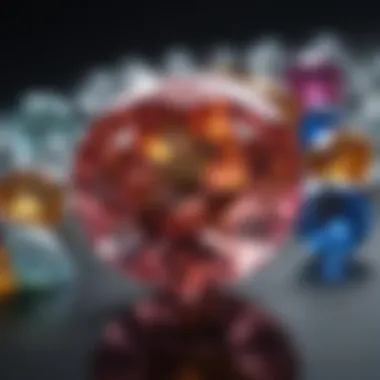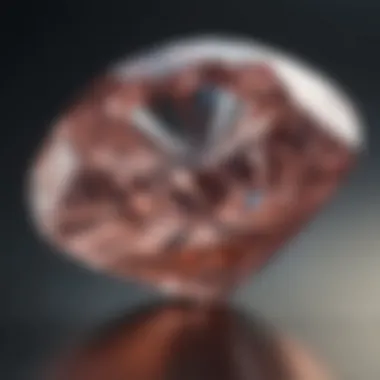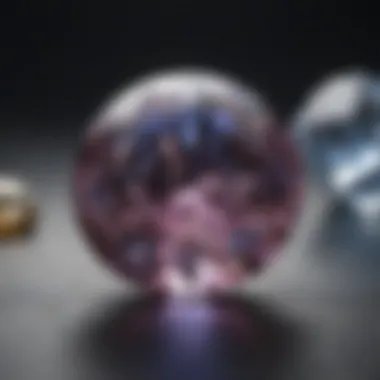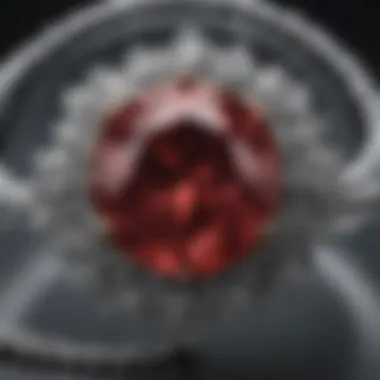Exploring the Color Significance of April 28th Birthstone


Intro
Diamonds hold a significant place in human culture, especially for those born on April 28th. The name "diamond" comes from the Greek word "adamas," meaning invincible. This luxurious gemstone is much more than a symbol of wealth; it embodies profound color meanings. Understanding these meanings enriches not only the appreciation of diamonds but also their application in various contexts, including jewelry design and metaphysical practices.
Gemstone Overview
Definition and Origins
A diamond is a crystalline form of carbon, known for its impressive clarity and unparalleled hardness. Found naturally in various locations around the globe, diamonds have been cherished since ancient times. Their brilliance and unique optical properties occur due to the way they refract light. This gemstone's intrinsic quality has made it a popular choice for engagement rings, a tradition bolstered in the 20th century by marketing campaigns from companies like De Beers.
Historical Significance
Historically, diamonds were believed to possess mystical properties. Ancient cultures attributed them with powers to protect against evils and enhance strength. They were worn by royalty and were often embedded in ceremonial regalia. Today, diamonds continue to hold significant cultural value across various societies, further enhancing their allure.
Gemstone Properties
Hardness and Durability
Handling diamond requires care, even though it ranks 10 on the Mohs scale of hardness, making it the hardest known natural material. This durability does not imply indestructibility.
Color and Clarity
Diamonds are often associated with their colorless quality, although they come in numerous colors, including yellow, blue, and pink. The famous "Fancy Color" diamonds are valued based on color hue, tone, and saturation. Each color has its own symbolism:
- White Diamonds: purity and clarity
- Yellow Diamonds: cheerfulness and optimism
- Blue Diamonds: serenity and tranquility
An understanding of these colors can enhance a collector's appreciation and a designer's creativity.
"The unique qualities of diamonds astound both gemstone enthusiasts and those new to the world of gems. Understanding these properties is crucial for anyone involved in the gemstone trade."
Intro to April Birthstones
April is a month celebrated not only for its springtime beauty but also for its distinctive birthstone, the diamond. Birthstones carry a deep significance rooted in culture, tradition, and even healing beliefs. For individuals born in April, this association with diamonds transcends mere ornamentation and extends into realms of personal identity, connection, and emotional well-being.
The focus on April birthstones is significant because it allows for a more profound understanding of how a single gem can embody various meanings. This section addresses the importance of diamonds as the birthstone for April, exploring their unique characteristics and the affect they hold in the lives of those born in this month.
gJewelry designers often draw inspiration from the bright clarity and resilience of diamonds in their creations. Thus, comprehending the history and meaning behind these stones is essential not only for enthusiasts but for collectors and those involved in jewelry design as well. By diving into the aspects of the April birthstones, one can reveal layers of meaning that come from historical narratives, cultural values, and metaphysical perspectives, enriching the appreciation of these precious gems.
The Concept of Birthstones
The idea of birthstones is a tradition that has roots going back to ancient civilizations. Each month is associated with a specific gemstone, often believed to bring good luck, protection, or healing properties to individuals born in that month. These ideas have evolved over the centuries, but the fundamental concept remains: gemstones symbolize traits and qualities that resonate with those who celebrate their birthdays during that time.
The modern list of birthstones was standardized by the American National Retail Jewelers Association in 1912. It serves as a guide that connects people with their personal gems. Birthstones can be more than decorative elements; they often serve as talismans, offering hope, love, and guidance. Understanding the significance behind the diamond as April's birthstone lays a foundation for an exploration of its colorful meanings.
Overview of April Birthstones
Diamonds, as the birthstone for April, enjoy a prestigious position among gemstones. Their physical properties, such as unparalleled hardness and brilliance, enhance their desirability. They are formed under high-pressure conditions deep within the Earth, which adds a layer of appreciation for their unique journey.
Symbolically, diamonds represent strength and clarity. Many view them as tokens of everlasting love and commitment, a reason why they dominate engagement rings. Moreover, they are often connected to various positive traits such as resilience, purity, and fidelity.
In addition to their emotional significance, diamonds are valued in many cultures for different reasons. For instance, in Indian culture, they are believed to bring wealth and prosperity. This cultural dimension adds depth to the appreciation of diamonds as more than mere aesthetic objects. Their multifaceted characteristics make diamonds a captivating subject for those interested in gemstones, jewelry, and the nuanced stories they tell.


Diamonds are not only a symbol of April but of enduring love and commitment, encapsulating complex emotions and historic traditions.
The Diamond as April's Birthstone
Diamonds hold a distinct place in the realm of gemstones, particularly as April's birthstone. Their importance extends beyond mere aesthetic beauty; they symbolize strength, clarity, and commitment. As an April-born individual, the diamond symbolizes various personal traits, making it a meaningful gem. For those who appreciate jewelry, diamonds signify elegance and allure, particularly when used in elaborate designs. This section will explore the historical significance of diamonds alongside their cultural perspectives, offering readers insights into why they are treasured across generations.
Historical Significance of Diamonds
Diamonds have a rich and storied past. Their origins date back to ancient civilizations where they were believed to possess protective properties. The term "diamond" comes from the Greek word "adamas," meaning invincible or untamed. Early humans recognized the diamond's unmatched hardness, which led to its association with strength and resilience. Kings and queens often adorned themselves with diamonds, signifying power and status in society.
Throughout history, diamonds have also been linked to various legendary beliefs. For example, it was said that diamonds could offer their wearers protection in battle. This led to their presence in crowns and armor. Additionally, diamonds played a role in important historical events, such as the famous Hope Diamond or the Koh-i-Noor, each wrapped in mystery and intrigue. These stories create a narrative that enriches the significance of diamonds as more than just gemstones; they become symbols of legacy.
Cultural Perspectives on Diamonds
Across cultures, diamonds resonate with different meanings that enhance their allure. In Western contexts, diamonds are most famously associated with engagement rings, symbolizing love and fidelity. This tradition solidified in the 20th century, driven by marketing campaigns that linked diamonds to everlasting love. However, the cultural significance of diamonds transcends this singular narrative.
In India, diamonds have been revered for centuries, often linked to wealth and prosperity. They are embedded in the cultural fabric, appearing in religious ceremonies and traditional attire. In contrast, African cultures have various interpretations of diamonds, from symbols of purity to representations of community resilience and pride.
"Diamonds, a universal symbol, transform across cultures, embodying emotions, stories, and identities."
The significance of diamonds in different cultures illuminates their varied meanings that resonate with individuals uniquely. Understanding these perspectives not only adds depth to the appreciation of diamonds but also fosters a greater understanding of their role in human relationships and traditions.
In summary, diamonds as April's birthstone embody a rich history and diverse cultural interpretations, making them one of the most sought after gemstones today. Their unique properties and symbolic meanings continue to captivate and inspire gemstone enthusiasts and jewelry collectors alike.
Color Properties of Diamonds
Understanding the color properties of diamonds is crucial for anyone interested in this April birthstone. Diamonds do not only shine with their inherent brilliance but also differ greatly in color. This section sheds light on various elements associated with diamond colors, benefits, and considerations that every gemstone enthusiast should be aware of.
Understanding Diamond Colors
Color in diamonds results from several factors, including the presence of trace elements, structural defects, and growth conditions. Most diamonds are colorless but varying degrees of shades and hues exist. Here are some common colors found in diamonds:
- Colorless: Represents purity and is typically the most sought-after due to its rarity.
- Yellow: Results from nitrogen impurities. It can be light to intense yellow.
- Brown: Often considered less valuable, these diamonds can range from light champagne to deep chocolate shades.
- Fancy Colors: There are also diamonds with vivid colors such as blue, pink, and green. They are rare and highly valued due to their uniqueness.
Consumers often select diamonds not only based on their clarity and cut but also their color properties. A diamond's color can serve as an expression of one's personality and taste. For example, while some may prefer the classic allure of a colorless diamond, others might be drawn to the romantic warmth of a pink diamond.
Color Grading Systems
To ensure transparency and consistency in the diamond industry, color grading systems are employed. The most commonly recognized grading scale is from the Gemological Institute of America (GIA). This system rates diamonds on a scale from D (colorless) to Z (light yellow or brown). Understanding these grades helps collectors and buyers make informed decisions.
Key points of the GIA Color Grading Scale include:
- D-F Range: Colorless diamonds. These are the highest quality in terms of color, reflecting the utmost clarity and brilliance.
- G-J Range: Near-colorless diamonds. These may show slight tones but still maintain significant value.
- K-M Range: Faint yellow diamonds. While not considered as valuable as the higher grades, they can be a more affordable option for buyers.
- N-Z Range: Light yellow or brown. Prices decrease as diamonds fall into this category.
More information about these grading systems can be explored at Gemological Institute of America.
"The color of a diamond is an essential characteristic that influences its overall value and aesthetic appeal. Understanding these properties allows collectors to appreciate their diamonds more deeply."
By grasping the nuances of diamond colors and their grading, enthusiasts can make educated choices that align with their personal style, investment goals, and the emotional significance attached to these timeless gemstones.
Symbolism of Diamond Colors


The symbolism of diamond colors extends far beyond mere aesthetics. Diamonds, particularly those representing April births, carry distinctive meanings linked to their hues. This section explores how these colors resonate within various cultural and personal contexts, contributing to the allure and significance of diamonds in jewelry and personal expression.
The Meaning of Colorless Diamonds
Colorless diamonds are often associated with purity and transparency. They symbolize clarity in intentions and a certain uncompromising standard in one's beliefs. For many, wearing a colorless diamond is seen as a mark of sophistication and elegance. It represents an unwavering commitment to genuine values and honesty. This significance makes colorless diamonds a favored choice for engagement rings, embodying the purity of love and commitment. Moreover, their versatility permits them to complement any attire or occasion, making them a staple in many collections.
Fancy Colored Diamonds and Their Significance
Colored diamonds add another dimension to the symbolism associated with this gemstone. Each hue carries its unique significance:
Blue Diamonds
Blue diamonds are renowned for their calming presence. This color is often linked to tranquility, wisdom, and peace. The rarity of blue diamonds adds to their mystique, making them highly sought after. Their deep, mesmerizing hue can symbolize depth of feelings in relationships. Choosing a blue diamond can also signify a desire for calm in life's tumultuous moments, offering both aesthetic beauty and profound personal significance.
Pink Diamonds
Pink diamonds stand for love, affection, and emotional strength. Their warm and inviting color evokes feelings of compassion and tenderness. The presence of a pink diamond in jewelry is often interpreted as a representation of romance and emotional connection. These diamonds are becoming increasingly popular as they symbolize new beginnings in relationships. Their limited availability further enhances their appeal, creating an association with exclusivity and luxury.
Yellow Diamonds
Yellow diamonds exude a sense of happiness and positivity. Their cheerful color symbolizes joy, prosperity, and vitality. Wearing a yellow diamond can reflect an energetic and optimistic outlook on life. These stones are often seen as a beacon of sunlight, enhancing the wearer’s mood and brightening their presence. As popular choices for statement pieces, yellow diamonds can also embody a unique sense of style, allowing individuals to express their vibrant personalities.
"The color of a diamond can reveal not just its beauty but also its deeper meanings and the emotions it evokes."
The various colors of diamonds, whether traditional or fancy-colored, might serve as potent symbols. They allow individuals to choose stones that resonate with their personalities or sentiments. Each diamond can convey a message, be it of love, strength, or joy.
Metaphysical Properties of Diamond Colors
The metaphysical properties of diamond colors hold significant importance within the realms of crystal healing, spirituality, and emotional well-being. Each hue encapsulates a unique vibration and energy that practitioners believe can aid individuals in various aspects of their lives. This topic aims to deepen understanding among gemstone enthusiasts about how colors influence emotional and spiritual experiences.
Diamonds, being a powerful symbol in many cultures, are often considered to excel in enhancing intuition and spiritual awareness. When discussing the metaphysical properties, one must consider the following aspects:
- Color Energy: Each color represents different traits and energies, influencing various number of aspects in life.
- Healing Potential: Many believe that diamond colors have specific healing capacities that can aid in both physical and emotional healing.
- Connection to Intentions: When used in rituals or meditations, the energy from diamond colors can amplify personal intentions, enhancing focus and clarity.
Understanding these properties is particularly relevant for collectors, jewelry designers, and enthusiasts who appreciate not just the aesthetic value of diamonds but also their deeper metaphysical implications.
Crystal Healing with Diamonds
Crystal healing with diamonds incorporates a variety of practices aimed at harnessing the gemstones' energy. Practitioners often use different colored diamonds for specific healing purposes. Here are some key points:
- Clear Diamonds: These are often associated with purity, enhancing clarity of thought and energy.
- Blue Diamonds: Linked with calmness and communication, they may help address issues of self-expression.
- Pink Diamonds: Considered to promote love and compassion, these diamonds can aid in emotional healing.
When using diamonds in a healing context, it is crucial to select a stone that resonates with one’s personal needs. Placement of the diamond can also have an effect; wearing them as jewelry, having them in one’s living space, or during meditation can create significant shifts in energy.
Emotional and Spiritual Affects of Diamond Colors
The emotional and spiritual affects of diamond colors can be profound. Different colors can evoke distinct emotional responses. By understanding these impacts, individuals can choose stones that support their emotional and spiritual journeys:
- Emotional Healing: Colored diamonds can aid in releasing old emotional patterns or trauma. For instance, yellow diamonds are thought to promote joy and optimism, while blue diamonds may assist in navigating emotional complexities.
- Spiritual Awareness: Each color has its own spiritual significance. Green diamonds are often tied to growth and healing, inviting prosperity and abundance into one’s life.
"Colors beckon different energies and emotions; understanding these facets can guide individuals in their personal and spiritual growth."


Diamonds in Jewelry Design
Diamonds hold a significant space in the realm of jewelry design, particularly for those born in April. Their stunning clarity and brilliance make them a preferred choice for various types of adornments. In this section, we will explore the pivotal role diamonds play in jewelry, highlighting specific elements and considerations that mark their importance in this field.
Diamonds are not just stones but serve as a language of sentiment and craftsmanship. When it comes to April birthstones, they symbolize strength, purity, and eternal love. These attributes contribute greatly to their desirability in jewelry pieces such as engagement rings, necklaces, and earrings. Furthermore, the unique color characteristics of diamonds allow for versatile designs that appeal to a variety of tastes.
Careful consideration of diamond cut, clarity, and color can enhance the beauty of any jewelry piece. A well-cut diamond reflects light beautifully, creating a captivating sparkle. This reflects not just the skill of the designer but also the emotional resonance of the piece itself. As such, diamonds often elevate jewelry beyond mere decoration into an art form.
Common Jewelry Styles for April Birthstones
The styles in which diamonds are often set can vary widely, reflecting different cultural influences and personal preferences. This versatility is a significant aspect of diamond jewelry design that appeals to collectors and enthusiasts alike.
- Engagement Rings: Diamonds are most famously featured as the primary stone in engagement rings. Their brilliance symbolizes commitment and love. Various settings, like solitaire or halo, can enhance the diamond’s beauty.
- Necklaces: Diamond pendants or layered diamond necklaces combine elegance with versatility. They can be worn on casual outings or special events, seamlessly transitioning across occasions.
- Earrings: Studs, hoops, or drop earrings often utilize diamonds extensively. The use of diamonds in earrings can enhance the wearer’s overall look, adding a touch of sophistication.
While these styles are common, the incorporation of personal touches can make the piece unique. Engraving a special date or combining the diamond with other gemstones can reflect the wearer's individuality.
Trends in Diamond Jewelry
In recent years, diamond jewelry has seen evolving trends that reflect contemporary tastes. Here are some noteworthy trends relevant to diamond usage in jewelry design:
- Sustainable Sourcing: Consumers increasingly seek ethically sourced diamonds. Lab-created diamonds are gaining popularity, offering a conflict-free alternative that does not compromise quality.
- Mixed Materials: Designers are now blending diamonds with unexpected materials such as wood or resin to create distinctive styles that stand out.
- Vintage Revival: Vintage-inspired designs, such as Art Deco or Victorian styles, are resurging. These pieces often showcase intricate settings that enhance the diamond's allure.
The diamond’s significance in jewelry design transcends mere aesthetics. It reflects emotions, traditions, and the artistry of skilled designers.
Care and Maintenance of Diamond Gemstones
Care and maintenance of diamond gemstones is crucial for preserving their beauty and value. Diamonds, known for their hardness and brilliance, still require thoughtful care. Ensuring that these precious stones are well-maintained enhances their longevity and aesthetic appeal. Furthermore, proper care helps avoid costly repairs or replacements, which can be detrimental to anyone’s budget. This section will cover cleaning guidelines and long-term care practices, which are essential for any gemstone enthusiast, collector, or jewelry designer.
Cleaning Guidelines for Diamonds
Keeping diamonds clean is vital for showcasing their brilliance. Here are some practical cleaning guidelines:
- Use Warm Soapy Water: Mix a few drops of mild dish soap in warm water. Soak your diamonds in the solution for about 20 to 30 minutes.
- Soft-bristled Brush: After soaking, use a soft-bristled toothbrush to gently scrub the diamond. This helps remove any dirt or oils stuck in the settings.
- Rinse Thoroughly: Rinse the diamond under cool, running water to eliminate soap. Make sure to close the drain to prevent accidents.
- Dry with a Lint-free Cloth: Pat the diamond dry with a soft, lint-free cloth. Avoid paper towels, as these may scratch the stone.
- Professional Cleaning: If simple cleaning doesn’t restore the diamond's luster, consider professional cleaning services which often employ ultrasonic cleaning techniques.
Long-term Care for Diamond Jewelry
Long-term care of diamond jewelry involves more than just cleaning. It encompasses preventive measures to maintain its value and appearance:
- Proper Storage: Store diamonds in a soft pouch or separate compartments within your jewelry box to prevent scratches.
- Avoid Harsh Chemicals: Exposure to products containing chlorine, bleach, and other harsh chemicals can damage jewelry. Always remove diamonds when cleaning or applying beauty products.
- Regular Inspections: Schedule regular check-ups with a jeweler to ensure the setting remains stable, and examine the diamond for any signs of wear.
- Safe Wearing Practices: Avoid wearing diamond rings or earrings during activities that may cause stress, such as exercising or gardening. This practice reduces the likelihood of accidental damage.
- Insurance Coverage: Consider insuring your diamond jewelry. This ensures financial protection against loss or theft, which many collectors find invaluable.
"Regular maintenance of diamonds not only enhances their appearance but protects your investment for years to come."
By adhering to these cleaning and care guidelines, diamond owners can ensure their gemstones remain in impeccable condition, allowing them to be cherished for generations.
The End
The final thoughts of this article encapsulate the significance of April's birthstone, the diamond, particularly focusing on its color symbolism. Diamonds are much more than mere adornments; they are steeped in history, culture, and meaning. For individuals born on April 28th, this gem serves as a representation of their identity and aspirations.
The importance of understanding diamond colors cannot be overstated. Each hue conveys unique attributes and emotional connections. For instance, blue diamonds symbolize calmness and serenity, while pink diamonds can represent love and compassion. By recognizing these meanings, wearers can forge a personal connection with their gemstone, enriching their experience.
For those engaged in jewelry design, knowledge of diamond meanings enhances creativity and elegance in their craft. A jewelry piece may not only be about aesthetics but also about the sentiments the color invokes. From the refinement of the classic clear diamond to the boldness of colored variants, designers have versatile options at their disposal.
Additionally, the metaphysical properties associated with various diamond colors lend a layer of depth to this significance. Crystal healing practices often cite these stones for their emotional and spiritual benefits. Becoming acquainted with these aspects may also aid collectors and enthusiasts in their pursuits, helping them make informed choices.
"In every diamond lies a story, waiting for someone to discover it."
Reflecting on the enduring legacy of April birthstones, particularly diamonds, one can appreciate their role across generations and cultures. As global trends evolve, the enduring charm of diamonds remains steadfast,culminating in their unique position as gifts and personal tokens for those celebrating their birthdays in April.
In summary, the exploration of the color significance of diamonds offers a comprehensive insight into their multifaceted nature, making this birthstone all the more special for those born on April 28th.



